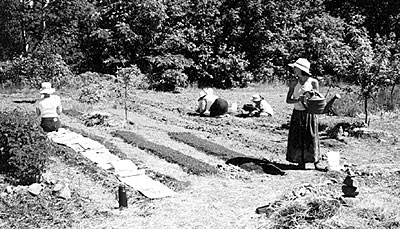 |
| Photo courtesy of Blessed Maine Herbs. |
By Gail Faith Edwards
The spring equinox approaches, and a new growing season begins! The calendar below details the steps we took in planting Blessed Maine Herb Farm’s gardens last spring and can guide you with your own herb garden. Blessings!
March 18 –
Today we planted six flats of Rosa rugosa seeds that we saved from last year’s fruits. We dried the rose hips thoroughly after we harvested them, then placed the whole hips in a paper bag and placed that in an airtight container. Just before planting, we break up the hips and separate the seeds. We scatter the seeds quite thickly in a flat or in a well worked bed in the greenhouse. Germination usually takes four to six weeks; these seeds do need a period of cold stratification. I’ve been told that Rosa rugosa cannot be planted this way and do not come true from seed, but I’ve been doing this for years and have beautiful roses.
We also seeded lavender, bee balm, feverfew, mullein, anise hyssop, rosemary, delphinium, ginkgo, codonopsis, lemon balm, lady’s mantle, angelica and yarrow. Most of our herb seeds come from Johnny’s Selected Seeds or FEDCO – local seed companies with reputations for reliable seeds. We also like Abundant Life Seed Foundation in Port Townsend, Washington; Elixir Farm; and Richter’s in Goodwood, Ontario. The seeds we planted today will have several weeks of cold stratification (a cold, moist period) in the greenhouse and will then germinate as the temperature warms.
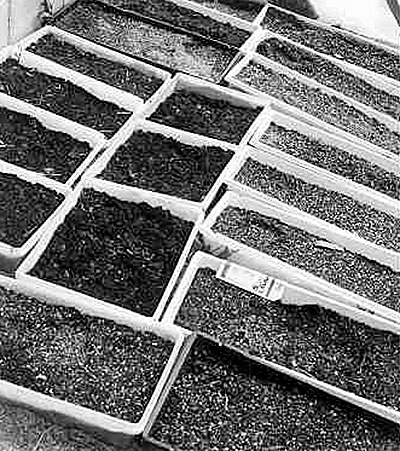 |
| Seed flats. Photo courtesy of Blessed Maine Herbs. |
March 31 –
After a night of heavy snow, the weather is perfect for working inside. We dug more beds in the greenhouse this morning and planted seeds of St. John’s wort, licorice, passion flower, wild marjoram and more Rosa rugosa. We also sowed lettuces and salad greens, broccoli, cabbage, cauliflower and kohlrabi seeds. Next we’ll plant seeds of fresh and dried flowers for pretty summer bouquets.
This week we also began retrieving the bare roots of medicinal plants that we dug from the garden, packed in sawdust and put into our root cellar last fall to store through the winter. We’ve been dividing the roots of valerian, astragalus, codonopsis, lavender and licorice. After careful division, the roots are counted, packed in sawdust, wrapped in recycled grain bags, and sent to FEDCO for its catalog sales. Working with the plants again feels great: smelling the rooty, earthy aromas, having soil under our fingernails, appreciating the incredible strength and beauty of a tiny sprout.
April 5 –
We started seeds of delphinium, statice, larkspur, sea lavender and more passion flower this week. The anise hyssop (licorice mint) is up, and so is the wild marjoram, licorice and salad greens. And the snow is coming down!
April 30 –
The greenhouse is packed with flats of seedlings, and everything is growing beautifully. Hollyhocks, delphiniums and larkspur are tall and green, licorice is putting out its second true leaves, and the long awaited passion flower vines are finally sprouting out of their dark, moist soil. The beds in the greenhouse are bursting with new growth. Lavender, lemon balm and angelica are all up, and so is yarrow. Anise hyssop and wild marjoram are fantastically lush, but we are still waiting for the lady’s mantle to pop up. Lots of hardy perennials are green and beautiful in the herb garden; everything seems to have wintered over fine. Angelica is sending up lots of new green leaves, garlic tops are up, and we’ve been digging roots of lavender, codonopsis and ginseng for spring sales. Spring cleanup is in full swing, and everyone is either raking or moving piles of wood. This is a good time to plant peas and assorted greens for summer salads.
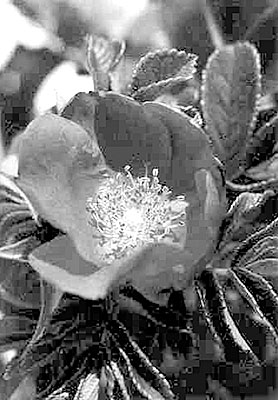 |
| Rosa rugosa. Photo courtesy of Blessed Maine Herbs. |
May 19 –
We have been preparing a site for a new shade house for ginseng, which we seeded last fall in the garden and which seems to be germinating well – right through a layer of hay and leaf mulch. I love the way the seedlings emerge, looking like delicate, unfurling claws reaching for the sun.
We’re eating dandelion and nettle greens!
The apprentices have transplanted two beds of wild marjoram and a long bed of anise hyssop in the garden. We’ve also planted three rows of strawberries and mulched them with newspaper and hay.
We’ve all been on our hands and knees in the garden making new beds. After going through with a rototiller, each bed is worked with a fork and is then thoroughly gone over by hand. All roots and rocks are removed to a depth of about 1 foot. We place roots in a wheelbarrow and dump them in a special compost pile on the edge of the herb garden. Rocks are mounded in piles and then collected in pails and either dumped at the side of the garden or used in a variety of creative ways. This tedious and time consuming work makes a fantastic growing area with very few weeds. When the bed is finished and smoothed, we sprinkle a light application of compost, and voila! We are ready to seed or transplant!
Once beds are planted, they are mulched on both sides with hay, usually with damp cardboard or newspaper underneath. Layering sheets of newspaper, cardboard, hay, kitchen waste and other organic matter over the soil is known as sheet mulching, or lasagna gardening. This is an effective yet simple and relatively easy technique to control weeds and build soil, and the mulch helps the soil retain moisture and stay cool through the heat of the summer. As summer progresses and the organic matter begins to decompose, we continue to add more layers of newspaper, hay and other organic matter. Because we don’t disturb the soil, plenty of beneficial bacterial and fungi grow. And because the soil in the planting bed is not compacted, worms and billions of microorganisms thrive, naturally building and enriching soil. The perennial herbs especially appreciate an environment like this. Most of our perennial herb garden is prepared and maintained this way, in a kind of permaculture. Garlic thrives with this treatment, as do astragalus, hyssop, lavender, licorice, mints and fruit trees.
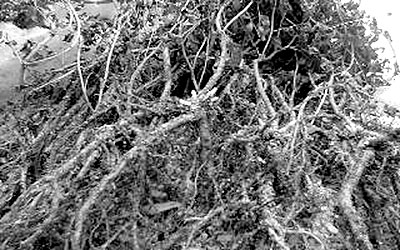 |
| Roots. Photo courtesy of Blessed Maine Herbs. |
Four apprentices work in the gardens three days a week now. Our gardens are filled with laughter and high energy, and the plants respond with beautiful growth. Bed preparation will continue for quite a while, as plenty of flats filled with healthy seedlings sit in the greenhouse, awaiting their homes in the herb garden. They require constant attention and daily watering now.
Our garlic has been sprinkled with compost and will soon get another layer of hay over that. Jack and I weeded the echinacea beds, and we planted a few more rows of potatoes. He put in some colorful Indian corn, and I planted two beds of calendula, more lettuce for salads, and a long bed of big red zinnias! I have enjoyed working on my hands and knees in the dirt since my childhood. I give thanks and praise for this little patch of earth to plant, tend and enjoy!
May 20 –
We’ve weeded, applied compost, and mulched beds of catnip, marshmallow and butterfly weed. We’re just finishing weeding several beds of hyssop. The plants remaining in the greenhouse are growing stronger by the day, and most are ready to be transplanted. Beginning this week they’ll all be finding their way into their new homes in the garden.
Cherry and apple trees are bursting into bloom along the hedgerow lining the driveway. Cheerful yellow masses of daffodils are peaking, and tulips are plump and about to open into sturdy blooms. Today we’re working in the herb house, pouring tinctures into bottles, labeling, and preparing our herbal products for Wildgathering! at the Athens Fairgrounds. (This year Wildgathering! is May 28-30.)
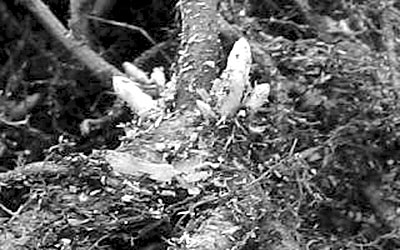 |
| Astragalus sprouts. Photo courtesy of Blessed Maine Herbs. |
May 29 –
We’ve had a full week of cloudy, rainy weather – just perfect for transplanting! We’ve put in a wide bed of lupines and another long bed of hollyhocks. We’ve also been cleaning up the lavender beds – cutting away dead parts of plants and weeding around them so that the fresh new growth underneath has full access to the sun. All of the lavender appears to have made it through winter, and the new growth looks strong and vibrant. After the beds are cleaned up, they’ll get a light sprinkling of compost, and more hay or other organic matter will be added to each side of the beds. We often add leaves of mineral-rich comfrey to these layers, and other soil nourishing herbs that we have in abundance, such as nettle and mugwort.
Zinnias and calendula are coming up strong, and everything we planted in the vegetable garden looks good. I cannot wait to eat the dill and fennel, cilantro and basil, fresh young onions, and all those salad greens. The peas are thick, and potatoes are sprouting through the soil. Yesterday we planted another batch of oats, five long rows of corn, green manures (rye, peas, clover and brassicas), and we put a few rows of cantaloupe in an especially rich corner of the garden.
We’ve begun creating shade for the ginseng beds. Ginseng has been growing successfully here at Blessed Maine Herb Farm for a decade. It now grows in two locations, and both need new shade arrangements. Ginseng requires between 75% and 90% shade and rich soil with plenty of humus.
Today a new bed of licorice will be transplanted, but the hot peppers still have a week or two in the greenhouse before we can put them into their new homes. Bed preparation continues …
June 10 –
We’ve been transplanting the last of the perennial herbs – lemon balm, lavender, licorice, rosemary, astragalus, bee balms, licorice and thyme – and lots of hollyhocks, foxglove and delphiniums into their beds. We’ve also planted blessed thistle, milk thistle and more calendula seeds. The oats are now an inch tall and bright emerald green. The apprentices have been diligently caring for beds of sage, lavender and echinacea, and everything in the garden is beautiful. All proceeds at a steady, calm pace.
June 17 –
Jack is already cutting hay with his hand scythe on this beautiful, sunny day! The hay looks so pretty drying this morning in long rows across the top of the garden. All plants are growing rapidly now.
The roses are just beginning to blossom. We’ve already harvested and processed several batches of their silky, pink petals, and many, many more will be gathered over the next month or so. When we gather roses from our rugosa plants, we’re careful to lift only the petals, leaving the center of the bloom behind. We’ll come back later to harvest the bright red fruits that form here, the rose hips, in late summer. Meanwhile, we’ve put up jars of rose oil, a jar of rose glycerite, and started a batch of rose mead.
Raspberry leaves are perfect for gathering and drying on screens in the herb house now. Horsetail is also drying on a screen there, and comfrey is ready for its first cutting. We’re eating fresh salads every day. We made flower essences with sage, rose and clematis blossoms.
Enjoy your spring gardening and may your work bring you great joy and an abundant harvest!
Gail Faith Edwards is a community herbalist, mother of four, and the author of Opening Our Wild Hearts to the Healing Herbs and Traversing the Wild Terrain of Menopause; Herbal Allies for Midlife Women and Men. She and her family run Blessed Maine Herb Farm, where they cultivate an acre of medicinal herbs to use in their herbal products. Gail offers herbal apprenticeships and other herbal study opportunities at her farm in Athens. Visit her online apothecary at www.blessedmaineherbs.com to peruse her offerings, read herb related articles, and find out about classes.
